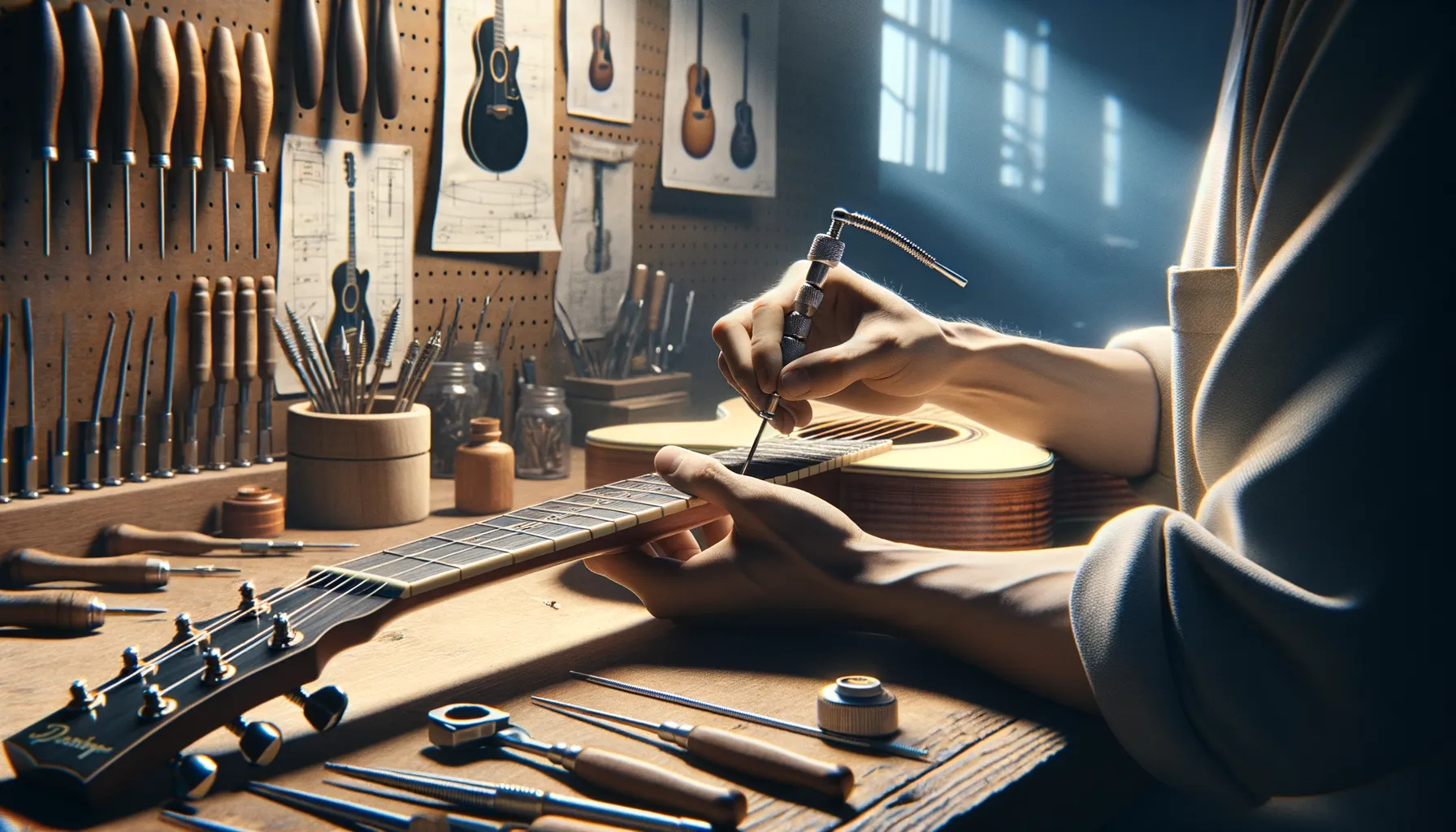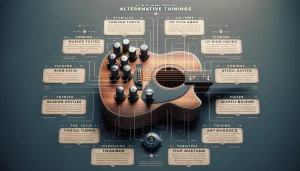Tools and Preparations for Setting Up Your Guitar
Your Guitar Setup Toolkit: Essentials You’ll Love
Before you dive headfirst into transforming your guitar, think of yourself as an artist preparing their palette. Your tools are the means to paint your masterpiece—a guitar that plays like butter sliding across warm toast. Here’s a handy list to get you started:
- Tuners: A reliable clip-on or pedal tuner ensures precision when adjusting intonation and action.
- Hex keys (Allen wrenches): These tiny saviors come in various sizes and will be indispensable for truss rod tweaks and saddle adjustments.
- String action ruler or feeler gauge: Essential for measuring string height with pinpoint accuracy.
- Screwdriver set: Trust me—having both Phillips and flathead screwdrivers at hand will save you from unnecessary frustration!
- Fresh strings: Never attempt a setup on old, lifeless strings. Treat yourself (and your ears) to a fresh set of your favorites.
A Few More Pre-Setup Musts You Can’t Skip
Ready? Not so fast! Preparation is half the battle. First, find a workspace where your guitar can sprawl out comfortably—trust me, hunching over in cramped spaces kills creativity. Lay down a soft, padded surface (even an old folded towel works!) to cradle your instrument without scratching its gorgeous finish.
Feeling nervous about those fine adjustments? Keep a notebook nearby to jot down original string heights or neck relief measurements—it’s like keeping a map before exploring the unknown. Oh, and don’t forget a good light source—it’s amazing how many things go unnoticed in dim room lighting. Would you paint in the dark? Exactly.
With these tools and prep hacks in your arsenal, you’re not just setting up your guitar—you’re putting love into every detail. And your fingers will feel it when they hit the fretboard.
Adjusting the Truss Rod for Neck Relief

Finding the Perfect Balance for Your Guitar Neck
Imagine your guitar’s neck as a highway. If it’s too flat, the strings buzz like bumper-to-bumper traffic. Too curved? It feels like you’re driving over speed bumps every time you fret a note. The secret to smooth playability lies in the truss rod. This little adjustment can turn chaos into harmony, giving your neck the perfect amount of relief for effortless playing.
To begin, grab an allen wrench or the tool your guitar demands. Locate the truss rod—often accessible at the headstock or near the body. Before turning anything, press down on the low E string at both the first and last frets. Check the space between the string and the 8th fret. Is there a gap wider than a piece of paper? Or none at all?
- Too much gap: Loosen the truss rod (turn counterclockwise).
- No gap or buzzing: Tighten it slightly (turn clockwise).
Take baby steps—less than a quarter-turn at a time. Let it settle for a few hours before re-evaluating. Trust me, this patience pays off! Once adjusted, your neck becomes the ultimate playground for your fingers, free of unwanted obstacles.
Setting the Action and String Height

Understanding the Sweet Spot for Your Strings
When it comes to playing your guitar, the height of your strings can either feel like gliding on silk or wrestling a stubborn mule. Setting the *action* – that’s the distance between your strings and fretboard – is where the magic happens. Too high, and your fingers will ache from the struggle. Too low? Welcome to the buzz-fest that no player wants at a gig.
Grab a ruler, or better yet, a specialized string action gauge. Measure around the 12th fret – this is your sweet spot for dialing in comfort and precision. Wondering what’s standard? It depends on your style. Here’s a quick reference:
- Electric guitars: Around 1.5mm–2mm for thinner strings; up to 2.5mm for the thicker ones.
- Acoustic players: A touch higher, usually 2mm–2.8mm.
- Bass lovers: Bring it up slightly more – between 2mm to 3.5mm for power and clarity.
Dialing in with Precision
Once you’ve got your numbers, head to the bridge. Most guitars allow you to adjust this via small screws on the saddles (electric) or by tweaking the entire bridge assembly (acoustics). Turn slowly – like you’re unlocking a treasure chest – and test after every adjustment. Listen. Feel. Let your fingers tell you when it’s just right.
Intonation: Ensuring Perfect Pitch Across the Fretboard

Why Intonation Is Your Guitar’s Secret Weapon
Imagine this: you’re nailing a solo, fingers dancing across the frets, only to notice—wait—something sounds… off. That’s the cruel mistress of poor intonation. Having your guitar perfectly in tune on open strings means nothing if your notes sour as you climb the neck. Intonation transforms your fretboard into a map where all notes land precisely where they’re supposed to, every single time.
The Steps to Sweet-Sounding Precision
Getting your intonation spot-on is easier than you think—and trust me, it’s worth every second. Here’s how to do it right:
- First, tune your guitar perfectly. Use a reliable tuner; your ears can’t always catch the subtleties here.
- Play the 12th-fret harmonic of a string, then compare it to the fretted note at the same fret. Do they match?
- If not, adjust the saddle position—forward for sharp, backward for flat—to fine-tune it.
It’s a little like being a musical mechanic, tweaking and fine-tuning until that lingering dissonance melts away. And the best part? You’ll feel the difference immediately when those upper frets sing true, whether you’re strumming or shredding.
Final Checks and Maintenance Tips for Long-Term Performance

Give Your Guitar the Love It Deserves
You’ve dialed in the perfect setup, but don’t pack away your tools just yet! A well-tuned guitar is like a living, breathing partner—it thrives on care and attention. Before you strum your first chord, give one last sweep to ensure all adjustments are locked in. Run your fingers along the fret edges; do they feel smooth? Check that every string rings cleanly, free of buzz, even with gentle playing. It’s these small details that create magic.
A quick tip? Keep a microfiber cloth handy. Wiping down strings after every session prevents grime from building up, prolonging both tone and string life. And don’t forget about cleaning those hard-to-reach spots around the bridge or pickups—dust loves to hide there!
Simple Habits for Long-Lasting Tune-ups
Setting up isn’t a one-and-done deal. A few easy routines can keep your guitar in top form for years:
- Loosen the strings slightly before storing your guitar long-term to relieve neck tension.
- Use a humidifier if you live in dry areas; wood can warp under extreme conditions.
- Schedule a truss rod check every season—temperature changes can subtly shift neck relief.
Treat your instrument like a companion, and it will reward you with harmonies that last a lifetime.






